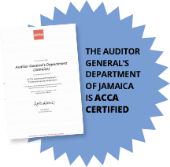
Managing Government’s Social Benefit Programmes
A cross-cutting performance audit of the distribution of social benefits to the poor and most vulnerable
One of Jamaica’s policy goals is to reduce the national poverty prevalence below 10 per cent by 2030. In
2021, PIOJ estimated Jamaica’s poverty rate to be 16.7 per cent of the population (12.3 per cent in 2023 as
per World Bank). The rate of poverty underscores the importance of effective social protection
programmes to achieve Vision 2030 Jamaica National Development Plan (NDP) – National Outcome No. 3 –
Effective Social Protection. The NDP and Social Protection Strategy recognized that the establishment of a
robust social welfare system is vital for ensuring the well-being of citizens. Therefore, it is important for
the Government to ensure that social benefits programmes are well-designed and efficiently managed so
that the most vulnerable individuals receive the benefits they require as quickly and effectively as possible.
For vulnerable populations to be adequately supported, the administration of social benefits should be
managed to optimize efficiency in distribution. We conducted a performance audit of Government social
benefit programmes to assess the effectiveness of the programmes’ administration in delivering social
benefits, considering the Vision 2030 NDP strategy for Jamaica to create and sustain an effective, efficient,
transparent, and objective system for delivering social assistance services and programmes. The audit
focused on selected non-contributory social benefit programmes, primarily assessing the legislative
framework and the administration of social benefit programmes, given the strategic direction of the NDP
and the subsequent Social Protection Strategy.
The audit found that efforts to reform social benefit distribution, a key part of the social protection system
overhaul, have not progressed. The effectiveness of the Government’s social benefit programmes
continues to be hindered by a fragmented and inefficient administrative structure, which is largely due to
challenges in implementing longstanding reform measures aimed at creating a more streamlined and
effective system of social benefit distribution. This has resulted in an environment where operational
deficiencies persist, hindering the optimal delivery of social benefits to those in need. The report is
structured into three parts and a case study section. Part One introduces the study. Part Two highlights
the legislative and policy framework overseeing social benefit programmes, while Part Three assesses the
administration of social benefit programmes.




 LinkedIn
LinkedIn Twitter
Twitter Youtube
Youtube
